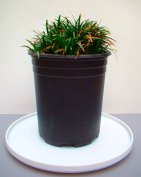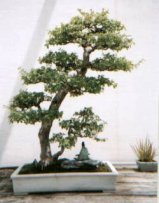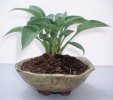
Although
they are created to "set off" a bonsai when displayed, each accent
plant can be an artistic design in itself. A plant as simple as a grass can
make an interesting or unusual counterpart. However, use small accent plants
in small containers for a balanced composition and to keep the focus on your
bonsai. Coordinate accent plants to be from the natural settings or regions
of your trees in order to impart harmonious, natural story-lines.
In
Japan, three components are often used to make this composition. A drawing,
painting, scroll, or Japanese calligraphic artwork may be centered on the
wall over the bonsai and accent plant. This 3-part bonsai harmony is contained
in its own space so the artistic message of the bonsai is enhanced. A plain
wall may be the best backdrop.
The above accent plant is a perennial begonia that grows in a flowerbed in
Georgia. It has small white flowers and is hardy. Dwarf hostas and other small,
unusual plants with or without flowers are good material.
A small, delicate, or unusual ceramic pot is used for accent plants; about 3 to 5 inches in width. Something abstract or with a hand-made quality will work well too for the many small flowering plants in nature that are abstract works of art in themselves.
Of the accent plants accompanying trees at the National Bonsai and Penjing Museum, the placement we observed was always to the right of the back line of the bonsai pot from the viewing position. The Chinese bonsai example above had been turned for a change of light exposure. Every bonsai has a front side for design and display purposes.
Chinese Bonsai (Penjing) with Accent Plant.
Photo taken at the National Bonsai and Penjing Museum.
On the forest floor is a Chinese figurine representing a scholar contemplating
nature which creates a tranquil scene.

Dwarf Sedum, Sedum Kamtschaticum A succulent with star shaped flowers. Very easy, fast growing groundcover for full sun. Its small size is good for accent plantings.
.1inch.jpg)


Accent Plant
enlarged.
Designing
Bonsai
Links
Plant Care
Articles:
Accent Plants

